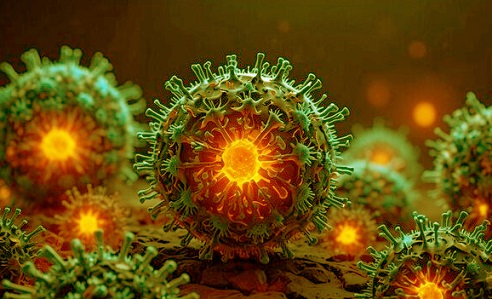LF.7.2.1, LP.8.1, and NP.1 - The Latest SARS-CoV-2 Variants That Are Becoming Predominant in Circulation
Nikhil Prasad Fact checked by:Thailand Medical News Team Dec 29, 2024 3 months, 1 day, 14 hours, 49 minutes ago
Medical News: The global fight against COVID-19 continues to evolve as new variants of SARS-CoV-2 emerge, challenging researchers, policymakers, and healthcare providers. Among these, LF.7.2.1, LP.8.1, and NP.1 have caught the attention of scientists worldwide for their unique virological and antigenic characteristics. Researchers from Peking University’s Biomedical Pioneering Innovation Center, Changping Laboratory, and Tsinghua University, among others in China, have conducted an in-depth analysis of these variants to understand their potential impact on public health.
 LF.7.2.1, LP.8.1, and NP.1 - The Latest SARS-CoV-2 Variants That Are Becoming Predominant in Circulation
Understanding the New Variants
LF.7.2.1, LP.8.1, and NP.1 - The Latest SARS-CoV-2 Variants That Are Becoming Predominant in Circulation
Understanding the New Variants
The variants LF.7.2.1, LP.8.1, and NP.1 are part of the JN.1 lineage, which has been rapidly gaining ground over previously dominant lineages such as XEC and KP.3.1.1. According to recent studies, these emerging variants exhibit unique mutations in the spike protein, which play a crucial role in their ability to infect cells and evade immune responses.
LF.7.2.1, first identified in Qatar, has spread across the Middle East and Europe, primarily due to its A475V mutation. This mutation allows the virus to evade Class 1 neutralizing antibodies, making it significantly more immune evasive than its predecessors. However, the A475V mutation also weakens its binding affinity to the human ACE2 receptor, which may limit its overall fitness.
NP.1, meanwhile, carries the S446N mutation in its receptor-binding domain, enhancing its immune evasion by escaping Class 3 antibodies. This
Medical News report highlights how these mutations make the variants more formidable against existing immunity.
LP.8.1, however, is the most concerning. With a combination of mutations such as R190S and H445R, it not only demonstrates strong immune evasion comparable to XEC but also exhibits enhanced ACE2 receptor engagement. This combination gives LP.8.1 a significant growth advantage, making it the fastest-spreading variant in America.
Key Findings from the Study
The research team conducted a series of experiments to assess the variants’ virological and antigenic properties. The study employed advanced techniques such as surface plasmon resonance (SPR) and pseudovirus neutralization assays to measure binding affinities and immune evasion.
-ACE2 Binding Efficiency: LF.7.2.1’s A475V mutation significantly reduces its ACE2 binding strength compared to earlier variants. In contrast, LP.8.1 maintains a robust binding efficiency, matching that of KP.3. This is critical as stronger ACE2 binding correlates with higher infectivity.
-Immune Evasion: The A475V mutation in LF.7.2.1 significantly enhances resistance to Class 1 neutralizing antibodies, making it the most immune evasive variant studied. NP.1’s S446N mutation further increases its ability to evade Class 3 antibodies. LP.8.1, while not
as immune evasive as LF.7.2.1, shows the highest overall balance of immune evasion and receptor engagement, giving it a significant growth edge.
-Growth Advantage: The study’s growth advantage model, based on logistic regression analysis of global sequence data, shows LP.8.1 as the most dominant variant in current circulation. LF.7.2.1 and NP.1, despite their immune evasive mutations, lag behind due to their compromised ACE2 engagement.
Implications for Public Health
These findings underline the evolutionary trade-offs in SARS-CoV-2 variants. While mutations that enhance immune evasion are advantageous for the virus in an immunized population, they often come at the cost of reduced receptor binding and infectivity. LP.8.1 appears to have overcome this trade-off, achieving a balance that supports both immune evasion and infectivity.
The rapid spread of LP.8.1, particularly in the Americas, raises concerns about vaccine efficacy and the need for updated booster doses. The study used plasma from individuals who had received two to three doses of inactivated vaccines and experienced breakthrough infections with BA.5 or BF.7 to test the neutralizing capability against these new variants. Results showed reduced neutralization capacity, emphasizing the need for vaccine modifications.
Study Details
The researchers employed pseudovirus systems to mimic the behavior of these variants in the lab. They analyzed the efficiency of neutralizing monoclonal antibodies targeting different classes of epitopes on the receptor-binding domain. Their findings indicate that the A435S mutation in MC.10.1, a related variant, and the S446N mutation in NP.1 alter spike protein conformation to enhance immune evasion. Additionally, the study confirmed the role of R190S and H445R mutations in LP.8.1’s dominance by improving receptor engagement and immune evasion simultaneously.
The study also examined how variants leverage mutations in the N-terminal domain to evade antibodies. These mutations, similar to those in KP.3.1.1 and XEC, allow variants like LF.7.2.1 to remain highly transmissible in populations with prior immunity.
Conclusions and Future Directions
In conclusion, the emergence of LF.7.2.1, NP.1, and LP.8.1 reflects the dynamic evolutionary pressure on SARS-CoV-2 to adapt in a world with widespread vaccination and natural immunity. While LF.7.2.1 demonstrates unprecedented immune evasion, its limited receptor engagement efficiency prevents it from becoming the dominant variant. NP.1, though slightly less immune evasive, also suffers from suboptimal receptor engagement. LP.8.1, on the other hand, has successfully balanced immune evasion with robust receptor binding, making it the variant to watch.
This research underscores the need for continuous genomic surveillance and rapid adaptation of vaccines to counteract these evolving threats. With LP.8.1 gaining dominance, updated boosters targeting its unique mutations could be critical in controlling its spread.
The study findings were published on a preprint server and are currently being peer reviewed.
https://www.biorxiv.org/content/10.1101/2024.12.27.630350v1
For the latest COVID-19 News, keep on logging to Thailand
Medical News.
Read Also:
https://www.thailandmedical.news/news/new-recombinant-sars-cov-2-variant-xek-likely-to-be-the-next-predominant-strain-by-late-winter-superseding-xec
https://www.thailandmedical.news/news/researchers-sound-alert-over-new-sars-cov-2-kp-3-1-1-xec-and-mc-1-variants
https://www.thailandmedical.news/articles/coronavirus
